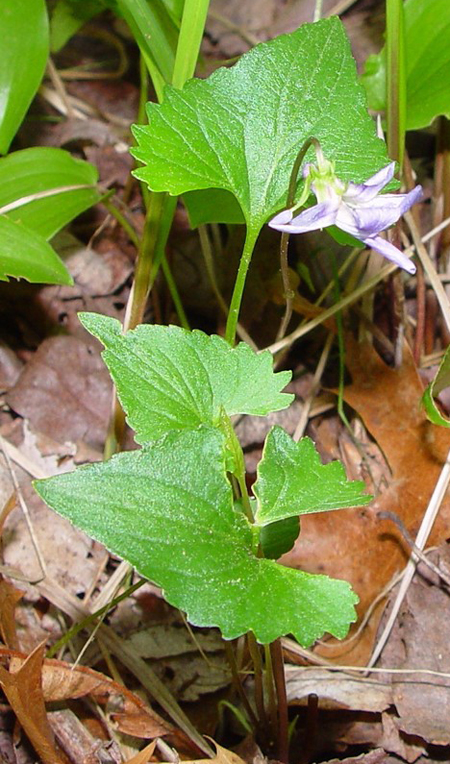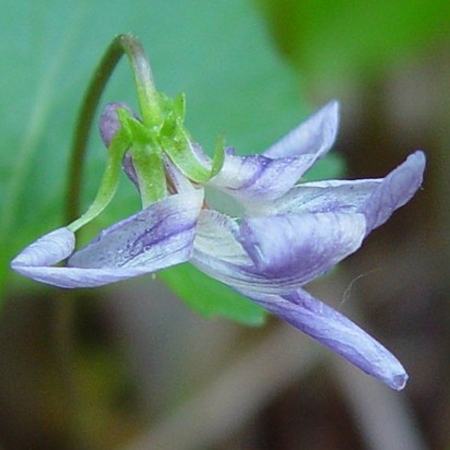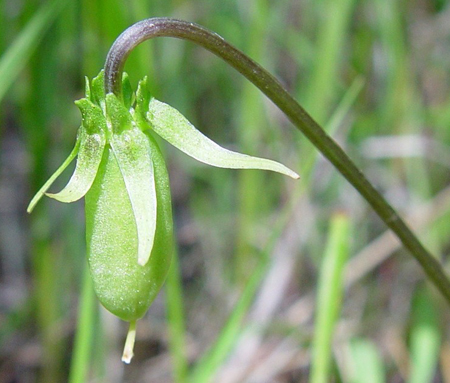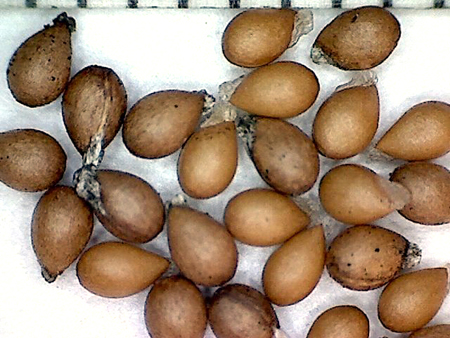Viola pectinata E.P.Bicknell
Common names:
Pectinate Violet
Synonyms:
Viola pectinata E.P.Bicknell, Torreya 4: 129. 1904; Viola brittoniana Pollard f. pectinata (E.P.Bicknell) Gil-ad, Boissiera 53: 54. 1997; Viola brittoniana Pollard var. pectinata (E.P.Bicknell) Alexander, in Gleason, New Ill. Fl. Northeastern U.S. 2: 558. 1952. TYPE: USA, New York, [Nassau Co.], L.[ong] I.[sland], Woodmere, border of salt marsh with V. brittoniana, 21 May 1904, E. P. Bicknell s.n. (holotype: NY00018233!, isotype: GH00067144!).
Description:
Acaulescent rosulate perennials from thick rhizome, ≤ 29 cm tall; foliage and peduncles green, lower surface of leaf blades commonly tinged with purple, surfaces glabrous or sparsely appressed-hirtellous along veins; stipules free, glandular-fimbriate; leaves ascending; leaf blades undivided, largest ≤ 65 × 87 mm, in chasmogamous flower longer than broad, narrowly ovate-triangular (rarely lance-triangular) with acute or acuminate (occasionally narrowly rounded) apex, in fruit as broad as to much broader than long, broadly ovate to deltate-reniform with abruptly acute apex, base subtruncate to cordate, margins prominently serrate and becoming pectinate near widest point of leaf, eciliate or ciliolate, apex sharply acute to subacuminate; chasmogamous peduncle held among the leaves; chasmogamous flower ≤ 22 mm; calyx glabrous, eciliate; lowest sepals linear-lanceolate to lanceolate, acuminate; auricles short or prominent, entire or erose, elongating to 3 mm in fruit; corolla blue to purple, throat white; spur short-globose; lateral petals densely bearded with filiform to narrowly linear hairs, spurred petal densely bearded; cleistogamous flowers produced after chasmogamous, on erect peduncles much shorter than to slightly surpassing the petioles; capsule 9–14(18) mm, yellow-green drying tan, unspotted, glabrous; seeds 1.3–1.9 × 0.8–1.3 mm, light to medium-dark brown, unspotted.
Similar species:
[edit description from V. affinis:] This species is is unique among the Borealiamericanae in its undivided leaf blades with prominently pectinate margins, and is similar to other species with strictly or nearly glabrous foliage and leaf blades longer than broad in chasmogamous flower that broaden substantially in fruit. In chasmogamous flower, besides the leaf blade features this species can be distinguished from V. affinis by its prominent quadrate auricles; from Viola cucullata by its lack of a conspicuously contrasting dark purple eyespot around the throat, long filiform to narrowly linear hairs in the lateral petal beards, and densely bearded spurred petal; from V. langloisii by its strongly ascending to erect leaves, and densely bearded spurred petal; from V. missouriensis by its linear-lanceolate to lanceolate acuminate eciliate sepals, and densely bearded spurred petal; and from V. pratincola and V. retusa by its sometimes sparsely appressed-hirtellous leaf laminas. In cleistogamous fruit, its distinctive leaves and unspotted light to medium-dark brown seeds separate it from V. communis, V. cucullata, V. langloisii, V. pratincola and V. retusa; and additionally its unspotted cleistogamous capsule on an erect peduncle set it apart from Viola sororia [glabrous variant] and Viola sororia [hirsutuloides variant].
Ecology:
Moist sandy or peaty soils, sphagnous ground and seeps of coastal (sometimes brackish) marshes and riverbanks, and fields, meadows, trail edges, and forest clearings in formerly natural habitats.
Distribution:
Atlantic Coastal Plain, closely following the distribution of V. brittoniana, MA south to NC.
Rarity:
State listed in NJ [as V. brittoniana var. pectinata].
Phenology:
Chasmogamous flower April–June, chasmogamous fruit May–July, cleistogamous fruit July–September.
Affinities:
This species belongs to the Acaulescent Blue Violet lineage, sect. Nosphinium W.Becker, subsect. Boreali-Americanae (W.Becker) Gil-ad, in the Pedatifida species group.
Hybrids:
Hybridizes with V. brittoniana (Brainerd 1906b, 1924, Haines et al. 2011, Harvey Ballard, pers. comm.) and V. cucullata (Brainerd 1924). I have observed several specimens and a few living plants of the hybrid and found them to exhibit more or less precisely intermediate characteristics of chasmogamous flowers, foliage and cleistogamous capsule traits. No information on chasmogamous reproduction is available, but cleistogamous capsules in hybrid individuals transplanted from multiple sites in NJ and NC were fully formed and mostly or entirely full of viable seeds.
Comments:
Brainerd (1921b), Russell (1965), Ballard (2000), Weakley et al. (2000), and Little and McKinney (2015) included the present species in V. brittoniana, and McKinney (1992) and McKinney and Russell (2002) included it in V. pedatifida subsp. brittoniana, without formal recognition. Brainerd Baird (1942) and Alexander (1963) treated it as a variety, while Gil-ad (1995, 1997) made a new combination for it as a form, under V. brittoniana. Haines et al. (2011), however, maintained it as a distinct species. All authors prior to Haines et al. who explicitly mentioned this taxon by name asserted that it was identical to V. brittoniana sensu stricto in all features except for an undivided leaf blade. Gil-ad described some micromorphological differences in seed coat sculpturing. Haines et al. pointed out that the present taxon differed substantially from V. brittoniana in outline and marginal dentition and that crosses between the two taxa expressed intermediacy, indicating multi-genic differences in leaf blade morphology and not a simple allelic phenotype difference. More thorough examination of many specimens and a number of populations in the field, comparing this and V. brittoniana sensu stricto, have supported the argument of Haines et al., revealing a number of additional differences besides leaf cutting. These include a strongly triangular to deltate-triangular leaf blade outline, subcordate to truncate base, narrowly acute apex, numerous and pronounced marginal teeth, and additional micromorphological differences observed in lateral petal trichomes and seed surfaces. Although the present taxon grows as scattered plants or very small populations in the immediate vicinity of V. brittoniana in the northern states, it commonly forms substantial to large uniform populations well removed from the latter species in Virginia and the Carolinas. Furthermore, harvested mature cleistogamous seeds from living plants from New Jersey are statistically indistinguishable in dimensions from V. brittoniana in the area, whereas seeds from plants in the mid-Atlantic Coastal Plain are statistically larger than seeds of V. brittoniana taken from the same area. The current evidence indicates that the present taxon is divergent from V. brittoniana in a number of vegetative and reproductive traits, and in the southern half of its range the taxon maintains itself separately from V. brittoniana. Herbarium specimens and living plants of presumed F1 hybrids between the two taxa have been confirmed from throughout the range of the present species. Under the Unified Species Concept, the present taxon is justifiably maintained at species rank.
Literature Cited:
Alexander, E. J. 1963. Violaceae. In Gleason, H. A., The new Britton and Brown illustrated flora of the northeastern United States and adjacent Canada. Hafner Publishing Co., Inc., New York, NY. 552-567.
Ballard Jr., H. E. 2000. Violaceae. In Rhoads, A. (ed.). Flora of Pennsylvania. University of Pennsylvania Press, Philadelphia, PA. 700-710.
Brainerd, E. 1906b. Hybridism in the genus Viola,-III. Rhodora8: 49-60, plates 66-70.
Brainerd, E. 1921b. Violets of North America. Vermont Agricultural Experiment Station Bulletin 224: 1-172.
Brainerd, E. 1924. The natural violet hybrids of North America. Vermont Agricultural Experiment Station Bulletin 239: 1-205.
Brainerd Baird, V. 1942. Wild violets of North America. University of California Press, Berkeley, CA.
Fernald, M. L. 1950. Violaceae. In Gray’s Manual of Botany, 8th ed. American Book Company, New York, NY. 1022-1042.
Gil-ad, N. L. 1995. Systematics and evolution of Viola L. subsection Boreali-Americanae (W. Becker) Brizicky. Ph.D. dissertation. University of Michigan, Ann Arbor, MI.
Gil-ad, N. L. 1997. Systematics of Viola subsection Boreali-Americanae. Boissiera 53: 1-130.
Gleason, H. A. and A. Cronquist. 1991. Violaceae. In Manual of vascular plants of northeastern United States and adjacent Canada, 2nd ed. New York Botanical Garden, Bronx, NY. 157-163.
Haines, A., E. Farnsworth, and G. Morrison. 2011. Violaceae. In Flora Novae Angliae. Yale University Press, New Haven, CT. 873-886.
Little, R. J., and L. E. McKinney. 2015. Violaceae. In Flora of North America: Cucurbitaceae to Droseraceae, 106. Oxford University Press, New York, NY.
McKinney, L. E. 1992. A taxonomic revision of the acaulescent blue violets (Viola) of North America. Sida, Botanical Miscellany 7: 1-60.
McKinney, L. E., and N. H. Russell. 2002. Violaceae of the southeastern United States. Castanea 67: 369-379.
Russell, N. H. 1965. Violets (Viola) of the central and eastern United States: An introductory survey. Sida 2: 1-113.
Weakley, A. S., J. C. Ludwig, and J. F. Townsend. 2012. Violaceae. In Flora of Virginia. BRIT Press, Fort Worth, TX. 963-975.

Chasmogamous flowering habit by Arthur Haines, Native Plant Trust

Chasmogamous flower profile view by Arthur Haines, Native Plant Trust

Chasmogamous flower profile view by Arthur Haines, Native Plant Trust

Chasmogamous fruit by Arthur Haines, Native Plant Trust

Seeds from herbarium specimen: Transplanted from MA, peaty meadow along the Charles River, Deadham, F. F. Forbes donor, 28 Aug 1910, E. Brainerd 115 (UVMVT083979)

Seeds from herbarium specimen: Transplanted from NC, Gates Co., Gates School Road & Eure Road, H. Ballard 15-016W (BHO)

Map of the Pedatifida species group by Harvey Ballard